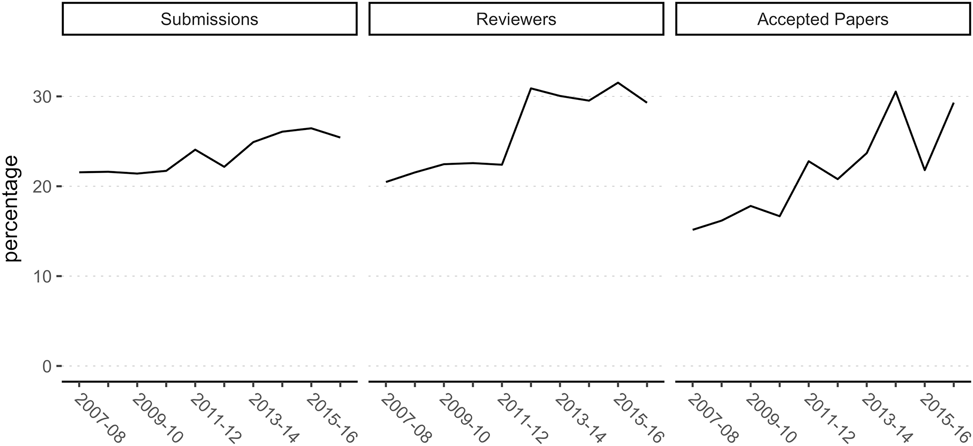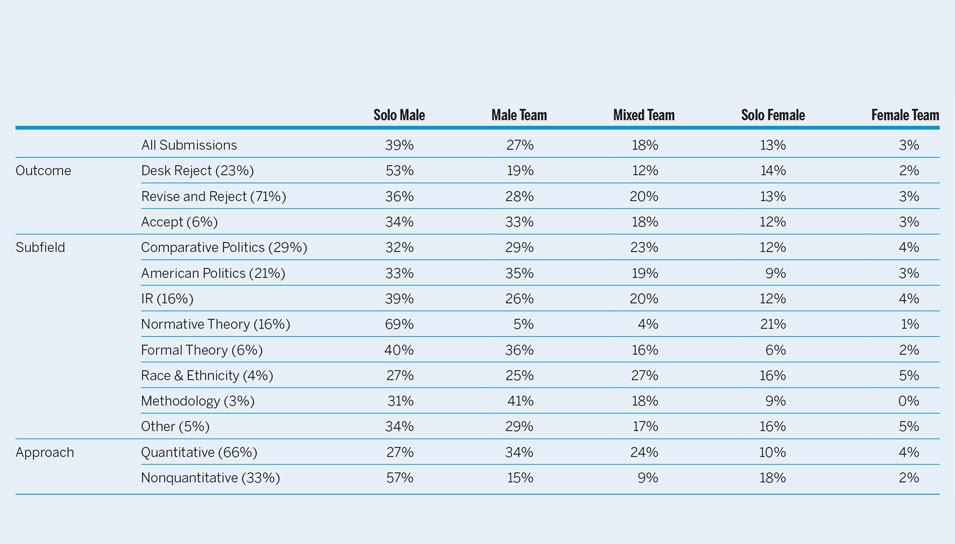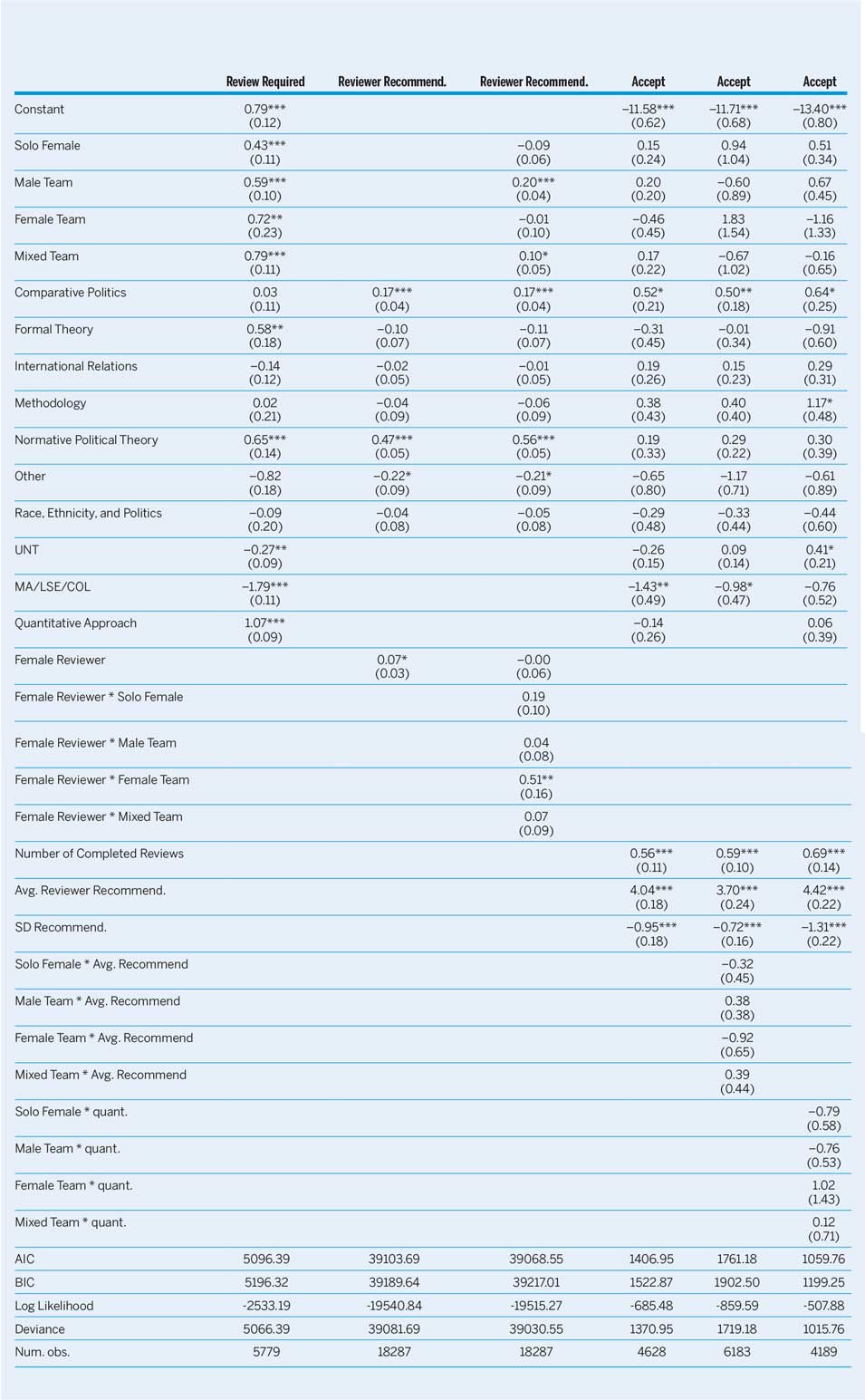As the premier outlet of the American Political Science Association (APSA), the American Political Science Review (APSR) understands itself as a journal of “general interest.” The journal receives and publishes manuscripts from all disciplinary subfields of political science and related disciplines covering different types of research designs and methodologies. However, as with many other top political science journals, Teele and Thelen (Reference Teele and Thelen2017) observe an underrepresentation of female authors in the APSR. They find that fewer than 23% of all authors in 634 articles published between 2000 and 2015 were female authors. In contrast, women make up about 31% of APSA-registered political scientists and around 40% of political science PhD students (Teele and Thelen Reference Teele and Thelen2017, 436). These numbers have raised discussion and underline previous findings on the distribution of female authors in published articles (Breuning and Sanders Reference Breuning and Sanders2007; Evans and Moulder Reference Evans and Moulder2011; Østby et al. Reference Østby, Strand, Nordås and Gleditsch2013).
Teele and Thelen (Reference Teele and Thelen2017) discuss different explanations for this underrepresentation. They emphasize potential bias stemming from differences in publication rates that reflect differences in the composition of male and female scholars working within specific subfields or applying different methodological approaches. Moreover, they refer to the rise of coauthorship, which is particularly driven by all-male collaborations (Fisher et al. Reference Fisher, Cobane, VanderVen and Cullen1998). They raise attention to two competing explanations which apply in particular with respect to the discipline’s top “generalist” journals: either women get rejected at higher rates or they are not submitting their research in the first place, possibly because of their expected higher rejection rate.
However, instead of focusing on published articles, one needs to study review processes to examine these explanations. With a rejection rate of around 95% of all manuscripts, the review process of the APSR has always been a matter of discussion—inside and outside of APSA. To select manuscripts for publication, the APSR applies a double-blind review process, which distinguishes between desk and reviewed rejections. It is noteworthy to mention that the new editorial team changed the process toward bilateral decision making between the lead editor and the responsible associate editor in August 2016. Among other things, this change aimed to reduce potential editor bias in particular subfields.
Taken together, our analysis points much more to the problem of a systematically low submission rate of female authors as explanation for the underrepresentation of women in published articles in the APSR rather than to biases within the editorial process itself.
For the APSR, a first study by Breuning et al. (Reference Breuning, Gross, Feinberg, Martinez, Sharma and Ishiyama2018) looked at the acceptance rates from two years of data on corresponding authors, finding no indication for gender bias in the editorial process. Yet, corresponding authors may constitute a specific subgroup of authors, and as Teele and Thelen (Reference Teele and Thelen2017) highlight, bias against female authors can arise at multiple stages in the editorial process: First, editors might be more likely to desk reject work by women. Second, male reviewers might be more negative in their evaluation of female-authored work, thereby biasing the editors’ decision. Third, editors might be less likely to publish female work after it was sent out for review.
To provide empirical insights into the review process of the APSR and to examine potential gender bias in particular, we collected all available data from the review process of the past ten-year period between July 2007 and June 2017, covering a total of 8,386 submissions and 18,289 reviews. Besides collecting the gender not only of corresponding but of all the authors and reviewers, we extracted information on the type of authorship, subfield, and outcome (i.e., whether a manuscript was desk rejected or sent out for review, and in case of the latter, whether it was accepted for publication). For about 70% of all submissions, we also have information on each manuscript’s methodological approach, distinguishing between quantitative and nonquantitative submissions.
Briefly summarized, our analysis shows a dominance of solo male submissions but no indication that approval rates are lower for female authors given their submission rates. Solo male authors have, in fact, the highest desk rejection rate. We also find that male reviewers are more likely to recommend rejection than female reviewers. Yet, it does not seem to influence the final outcome. As a journal of “general interest,” we can also examine distributions of gender across subfields and methodological approaches for which we do not find substantial differences. Taken together, our analysis points much more to the problem of a systematically low submission rate of female authors as explanation for the underrepresentation of women in published articles in the APSR rather than to biases within the editorial process itself.
In spite of general female underrepresentation, we notice, however, an increasing number of submissions from and acceptances of female authors as well as of participation of female reviewers, as shown in figure 1. Not shown here is that the share of collaboration between female and male authors is also increasing, whereas the share of solo male authors is decreasing. Both these trends correlate with an increasing share of females in the discipline. Nevertheless, the relative share of female authors published in our journal remains low.

Figure 1 Female Share among Submitting Authors, Invited Reviewers, and Authors of Accepted Papers for Yearly Editorial Terms
The descriptive statistics of gender across editorial outcomes, subfields, and methodological approaches in table 1 provide more insights into the explanatory power of the subgroup hypotheses of Teele and Thelen (Reference Teele and Thelen2017). Classified by the type of authorship, there is a comparatively high desk rejection rate of submissions by solo male authors on the one hand and a comparatively high share of male collaborative work among published papers on the other. Accordingly, we receive more male submissions, but male collaboration provides more success. In comparison, the share of solo female and team female papers remains astonishingly constant across outcomes, even though the share of collaboration among female authors is overall very low. With respect to subfield specificities, the distribution in Normative Theory differs strongly from other subfields and is characterized by a very high share of solo authors. This pattern also becomes apparent when we distinguish the submissions by methodological approach showing a much larger share of collaboration among quantitative submissions. According to Teele and Thelen (Reference Teele and Thelen2017), a potential explanation for gender bias is a tendency for journals to publish quantitative work presumably favoring male researchers. However, from looking at the descriptive statistics, no clear support for this thesis can be found. With Normative Theory, for example, the acceptance rate has been substantially above the submission rate in recent years, reaching a share of about 30% in 2015 and 2016.
Table 1 Editorial Outcomes, Subfield Submissions, and Methodological Approaches by Gender and Collaboration Type in the APSR, 2007–17

Note: For editorial outcomes, only manuscripts with a final decision and which were not withdrawn are included. Moreover, while the APSR editorial teams started to classify methodological approaches in July 2010, we lack the classification of 758 manuscripts before August 2016.
To draw more solid inferences about the role of gender in the review process of the APSR, we applied simple logit and ordered logit regression analyses to examine (1) the decision to send out a manuscript for review, (2) reviewer recommendations, and (3) the final editorial decision to publish a paper or not.
In comparison, the share of solo female and team female papers remains astonishingly constant across outcomes, even though the share of collaboration among female authors is overall very low.
Concerning the decision to send out a manuscript for review, we find that the probability is lowest for solo male authors when controlling for subfield, editorial team, and quantitative approach, as indicated in table A1. When calculating first differences, the probability for solo male authors is 5.0 [2.5, 7.5] percentage points lower than for solo female authors, and 6.6 [4.5, 9.0] percentage points lower than for all-male teams. Furthermore, collaborative work is less likely to be desk rejected regardless of the gender of the authors. Although quantitative work is more likely to be sent out than other approaches, there seems to be no difference between male and female authors. As the overall share of female authors among quantitative submissions (26% in 2016–17) is similar to nonquantitative submissions (24% in 2016–17), there is no indication that the higher desk rejection rate for nonquantitative submissions penalizes female authors, as hypothesized by Teele and Thelen (Reference Teele and Thelen2017).
With regard to reviewer recommendations, collaborative work is more likely to receive positive feedback, again, independent of the authors’ gender and controlling for subfield. As female reviewers seem to be less likely to recommend rejection, we also control whether this varies across authors’ gender. Female reviewers seem to favor all female teams, although the simulated confidence intervals of the first difference to receive a reject recommendation by a female reviewer compared to both male reviewers [-12.8, 3.3] and all male team submissions [-9.3, 4.4] include zero. On closer inspection of subfields, reviewers from Normative Political Theory and Comparative Politics are more positive than reviewers from American Politics.
Finally for the editors’ decision to publish a paper or not, there is no indication of discrimination against female authors. Furthermore, we do not find that editors follow reviewers’ recommendations more depending on the authors’ gender or that they treat female authors differently if they submit quantitative work as compared to nonquantitative work. This result is also reflected in the overall share of female authors among published articles which has fluctuated over the years but is on average about 24% for both quantitative and nonquantitative articles during our study period.
If we assume that editors are able to objectively judge the quality of manuscripts at the desk rejection stage of the editorial process without discriminating against gender, it speaks in favor of a lower average quality of solo male submissions.
In sum, we do not find indication for systematic differences in publication success rates based on gender in the APSR review process that point toward editorial or reviewer biases against women. Despite small differences in the recommendations by male and female reviewers, this does not seem to bias the editors’ decision whether or not a manuscript gets published. The diversity of submissions the APSR receives as a “general interest” journal, additionally, allowed us to examine differences across subfields and methodological approaches. However, none of these factors seems to result in a bias against the authors’ gender.
It is important to stress, however, that our analysis does not allow us to conclude that gender bias does not exist in the APSR. To do so, we lack objective information on the quality of manuscripts for similar manuscripts submitted by either male or female authors. Nevertheless, our results do not suggest that publication success differs systematically between authors’ gender with the exception that the probability for desk rejection is much higher for solo male authors. If we assume that editors are able to objectively judge the quality of manuscripts at the desk rejection stage of the editorial process without discriminating against gender, it speaks in favor of a lower average quality of solo male submissions. It would hint to concerns that male and female authors have different quality standards when submitting their work in the first place. With respect to the two competing explanations for gender bias raised by Teele and Thelen (Reference Teele and Thelen2017), bias of editorial decisions and bias among the submissions a journal receives, this result speaks much more in favor of the latter. As a consequence, if female authors in fact apply different standards than their male counterparts when deciding to submit a manuscript—for reasons that might, for example, be related to their expectation to be discriminated against or different perceptions of the quality of their own work—analyses of editorial gender bias such as ours face the problem of sample selection bias. It makes it difficult to assess the degree of gender bias for manuscripts of the same quality, which future studies need to try to address.
On the positive side, we see an increasing trend toward collaboration, in particular of mixed gender teams. However, a closer inspection of our analysis also reveals that women are less likely than men to be the first author when they act as the corresponding author. Out of the 1,504 submissions from mixed gender teams, in about 41% of the cases, women are the corresponding authors. It roughly corresponds to their share among all authors in mixed gender teams, around 44%. Out of these 41% of corresponding female authors, 72% are also first author. In contrast, the share is higher for male corresponding authors, who are in 79% of the cases also the first author of a manuscript. Thus, while more collaboration is clearly needed to increase the share of female authors, these numbers highlight the importance for collaboration among male and female authors to be conducted on equal terms.
ACKNOWLEDGMENTS
We thank our student assistants Ashrakat Elshehawy and Viktoria Semenova for assistance gathering the information on authors’ and reviewers’ gender. We thank Alyssa Taylor and Ben Lauderdale for helpful comments on earlier versions of this report.
Appendix
Table A1 Regression Analyses of Editorial Outcomes in the APSR 2007–2017








